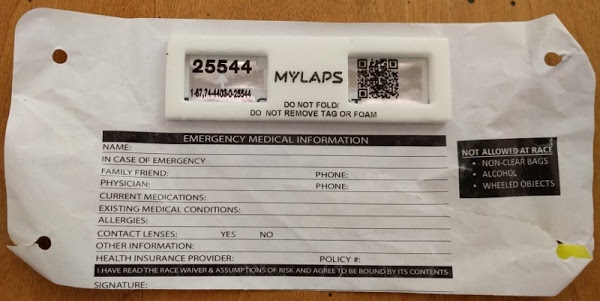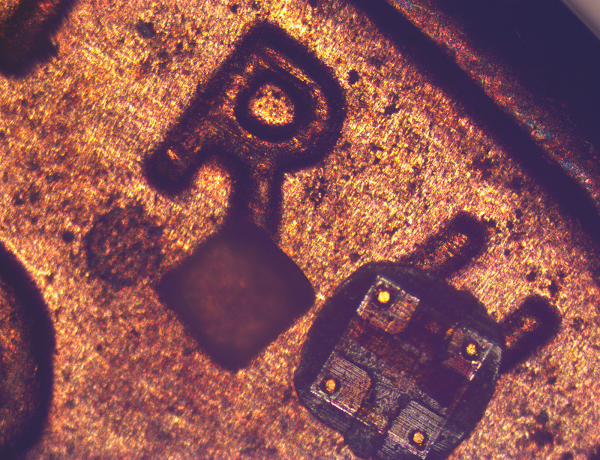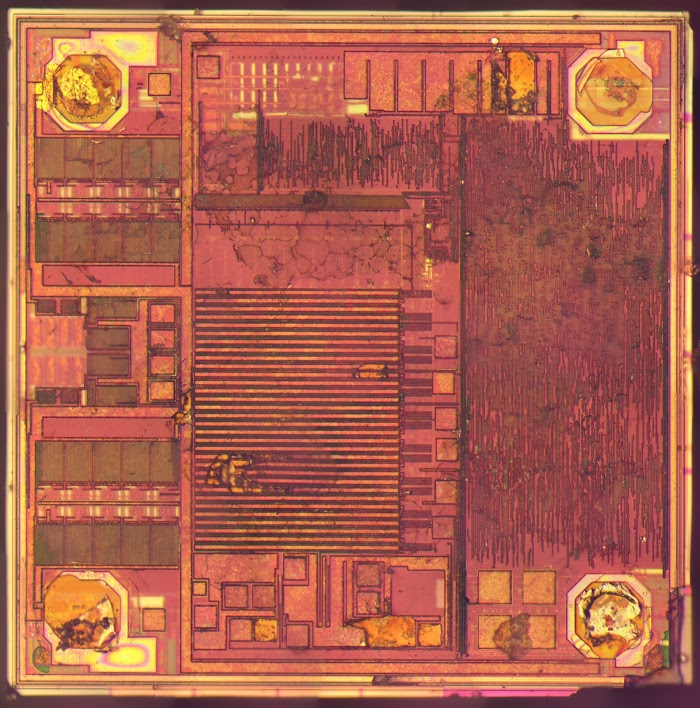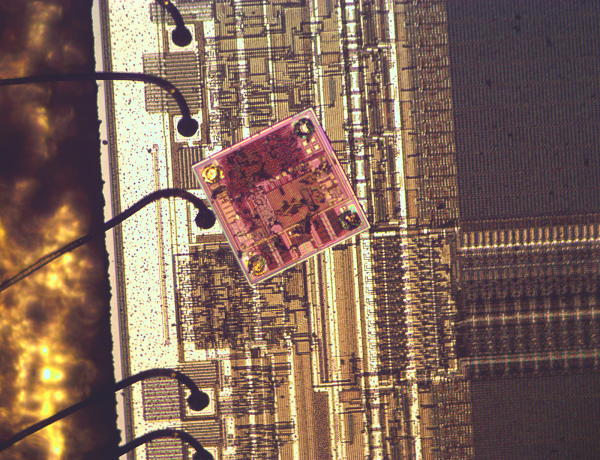How does a tiny chip time the runners in the Bay to Breakers race? In this article, I take die photos of the RFID chip used to track athletes during the race.
Bay to Breakers is the iconic San Francisco race, with tens of thousands of runners (many in costume and some in nothing) running 12km across the city. To determine their race time, each runner wears an identification bib. As you can see below, the back of the bib has a small foam rectangle with a metal foil antenna and a tiny chip underneath. The runners are tracked using a technology called RFID (Radio Frequency Identification).
At the beginning and end of the race, the runners cross special mats that contain antennas and broadcast ultra high frequency radio signals. The runner's RFID chip detects this signal and sends back the athlete's ID number, which is programmed into the chip. By tracking these ID numbers, the system determines the time each runner took to run the race. The cool thing about these RFID chips is they are powered by the received radio signal; they don't need a battery.
Mylaps, whose name appears on the foam rectangle, is a company that supplies sports timing systems: the bibs with embedded RFID chips, the detection mats, and portable detection hardware. The detection system is designed to handle large numbers of runners, scanning more than 50 tags per second.
Removing the foam reveals an unusually-shaped metal antenna, the tiny RFID chip (the black dot above the word "DO", and the barely-visible word "Smartrac". Studying the Smartrac website reveals that this chip is the Impinj Monza 4 RFID chip, which operates in the 860-960 MHz frequency range and is recommended for sports timing.
Getting the chip off the bib was a bit tricky. I softened the bib material in Goof Off, dissolved the aluminum antenna metal with HCl and removed the adhesive with a mysterious BGA adhesive solvent I ordered from Shenzhen.
The chip itself is remarkably tiny, about the size of a grain of salt. The picture below shows the chip on a penny, as seen through a microscope: for scale, a grain of salt is by the R and the chip is on the U (in TRUST). This is regular salt, by the way, not coarse sea salt or kosher salt. I spent a lot of time trying to find the chip when it fell on my desk, since it is practically a speck.
In the picture above, you can see the four round contact points where the chip was connected to the antenna. There's still a blob of epoxy or something around the die, making it hard to see the details. The chip decapsulation gurus use use boiling nitric and sulfuric acids to remove epoxy, but I'm not that hardcore so I heated the chip over a stove flame. This burned off the epoxy much better than I expected, making the die clearly visible as you can see in the next photo.
I took 34 die photos using my metallurgical microscope and stitched them together to get a hi-res photo. (I described the stitching process in detail here). The result is the die photo below (click it for the large image). Surprisingly, there is no identifying name or number on the chip. However, comparing my die photo with the picture in the datasheet confirms that the chip is the Monza 4 RFID chip.
I can identify some of the chip's layout, but the chip is too dense and has too many layers for me to reverse engineer the exact details. Thus, the description that follows is slightly speculative.
The four pins in the corners are where the antenna is connected. (The chip has four pins because two antennas can be used for improved detection.)
The left part of the chip is the analog logic, extracting power from the antenna, reading the transmitted signal, and modulating the return signal. The rectangles on the left are probably transistors and capacitors forming a charge pump to extract power from the radio signal (see patent 7,561,866).
The right third of the chip is so-called "random logic" that carries out the commands sent to the chip. According to the datasheet, the chip uses a digital logic finite state machine, so the chip probably doesn't have a full processor.
The 32 orderly stripes in the middle are the non-volatile memory (NVM). Above the stripes, the address decode circuitry is barely visible. The chip has 928 bits of storage (counting up the memory banks on the datasheet) so I suspect the memory is set up as a 32x29 array. Some NVM details are in patent 7307534.
Along the lower and right edges of the chip, red lines are visible; these connect chips together on the wafer for testing during manufacturing (patent 7307528).
To show how small the chip is, and how technology has changed, I put the RFID chip on top of an 8751 microcontroller die. The 8751 microcontroller is a chip in Intel's popular 8051 family dating from 1983. Note that the circuitry on the RFID chip is denser and the chip is much, much smaller. (The photo looks a bit photoshopped, but it genuinely is the RFID chip sitting on the surface of the 8751 die. I don't know why the RFID chip is pink.)
So, if you ran in the Bay to Breakers, that's the chip that tracked your time during the race. (There aren't a lot of other RFID die photos on the web, but a few are at Bunnie Studios, Zeptobars and ExtremeTech if you want to see more.)






Great post, thanks! What are the dimensions of the chip? Also, it looks like the bond pads are smaller than on contemporary devices -- any idea how the chip is attached to the plastic substrate and antennas?
ReplyDeleteHugo, the datasheet says the chip is 590 μm x 590 μm. Apparently the chip is attached to the antenna simply with adhesive, it's called flip chip bonding.
ReplyDeletePink makes it invisible
ReplyDelete